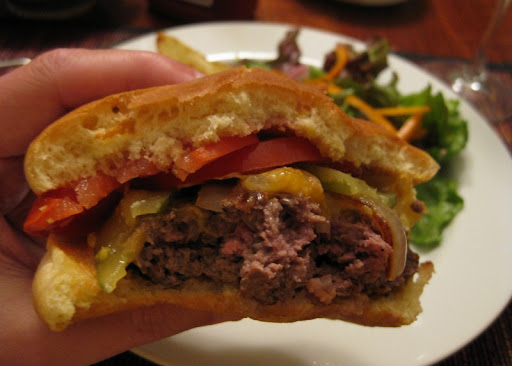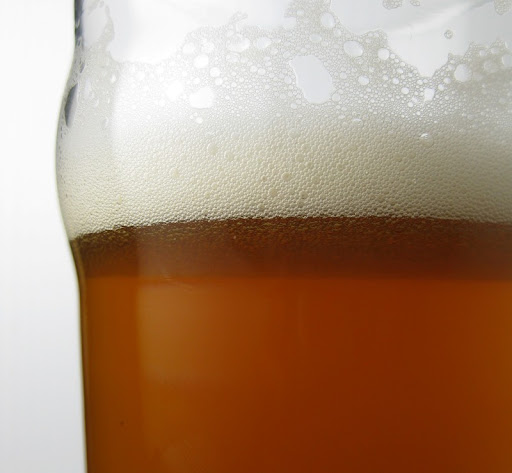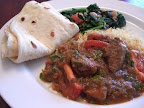
Recently, I was invited by a friend to join her and a group of others to "go to Ba Ren to eat really, really hot, spicy szechuan food." Mike was jealous, since he'd heard interesting things about the place - sorry Mike, you only get to see the pictures along with everyone else.
The place was a little intimidating initially, since not much English is spoken. I arrived at Ba Ren a couple minutes early and asked about our reservation. I was met with a bit of a blank stare and "reservation??" - which prompted me to dash back outside and await the rest of the group. Once strength in numbers arrived we were hustled to a large table in a side area, as far away from the main dining area as possible. So apparently you can make reservations - just don't expect them to be happy about it.
To start the meal, several of us perused a display case filled with intriguing chilled meat and vegetable dishes near the door. By gesturing to the server manning the station, we managed to procure a somewhat random variety of appetizers to bring back to our table. (I have since read that a selection of cold starters is a typical beginning to a Szechuan restaurant meal.)

The plate on the left holds thin-sliced jellied Pig's Ear on top of sliced Pork Tongue in the back, and another tasty meat of some kind in the front. The other plate holds marinated cucumber spears in the back, a salad of edamame and greens on top, and a really spicy chile-crusted meat of some sort. I'm told that one of the two unidentified meats was a tripe dish called Husband and Wife (at least that's what my friend thought it was), but we're not sure which. I liked the tongue a lot, and was pleasantly surprised by the intriguing crunch of the pig's ear. We've tried using pig ears at home, with much less success (one of the few instances where Fergus Henderson, our guide in these matters, has let us down).
Everything at Ba Ren is served family style which means the bigger group you dine with, the more dishes you get to taste. Along with our two plates of appetizers, we opted for six main dishes and a vegetable for our group of ten.
First up was Sliced Boiled Fish:

The fish was in a dark red sauce with a lot of cabbage and tons of spicy, mouth-numbing whole szechuan peppercorns. Overall it was tasty and not too hot if you avoided some of the peppercorns.
Chicken with Hot Peppers:

This was deep fried chicken pieces served among piles of cut-up dried chile peppers along with the obligatory szechuan peppercorns. It looked like it was going to be very fiery, but I was told that the dried chiles aren't meant to be eaten - they just flavor the cooking oil. I found this dish to be ok, but fairly one-dimensional.
Cut Beans:

Ba Ren's menu isn't always easy to decipher when reading the English translations - "Cut Beans" anyone? It turns out that this was a very savory dish of stir-fried green beans seasoned with plenty of garlic and ginger and only a pinch of szechuan pepper.
Dry-Cooked Lamb:

The spicy, tender lamb was quite nice, especially paired with the crunchy fresh bean sprouts scattered throughout.
Ma Po Tofu:

Simply-prepared with an earthy, slightly pungent red sauce and generous cubes of soft tofu, this was really good over steamed rice. Spicy, but not over-the-top. I think I had thirds of this one.
Braised Duck with Taro:

The braised duck was one of the few dishes without a lot of heat from either chiles or Szechuan pepper. It was rich and flavorful, although a bit challenging to eat since the small chunks were bone-in. While nobody was enamored of the jelly-like taro, the duck was a winner.
As you can tell from most of the photos, my fellow diners were quite patient with me and generally allowed me to get a shot of each dish before everyone started to dig-in. Patient until we started nearing the end, that is, when everyone was enthusiastically and cheerfully eating without much pause. Thus, the meager photo of a morsel of duck on my plate above, and a lone shrimp below.
Crispy Shrimp with Hot Peppers:

These two-bite crispy fried shrimp had both sweet and salty components in the batter and were infused with the tongue-tingling flavor of Szechuan peppercorns.

The shrimp were quite addictive - if there had been anything other than a huge plate of chiles remaining on the shrimp platter I would have helped myself to another!
My friend had visited Ba Ren several times before, and on previous visits she had been served a complementary rice pudding-like dessert. After finishing our meal, one of the members of our group who spoke Mandarin asked about the dessert. The waitress responded (in Mandarin) that she hadn't planned to serve it, as many customers do not want it, but yes, she would bring it out.
To our surprise, this is what we were served:

Chicken Noodle Soup with Pea Sprouts and Sour Pickled Greens (aka Dessert Soup).
This was a really nice, comforting way to restore my spice-abused taste buds. I especially liked the vibrancy of the pickled greens. Later I learned that a clear, mild soup and pickles are traditional endings to a multi-course Szechuan meal. Who knew?
While the restaurant still intimidates me quite a bit, I definitely want to return.
Ba Ren Szechuan Restaurant
4957 Diane Ave (between Clairemont Mesa Blvd & Conrad Ave)
San Diego, CA 92117
(858) 279-2520

































